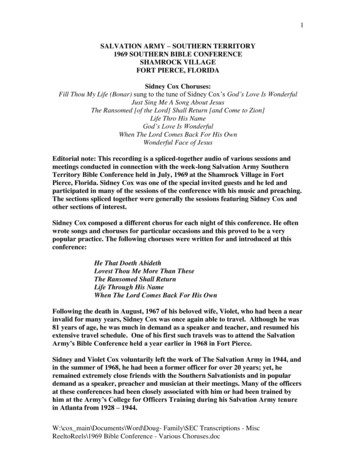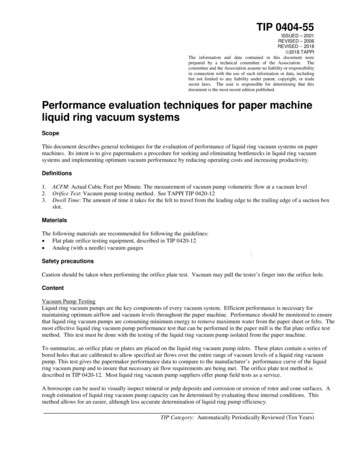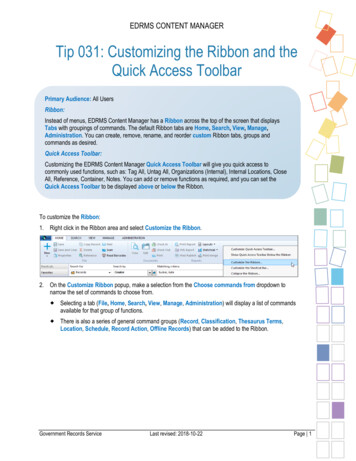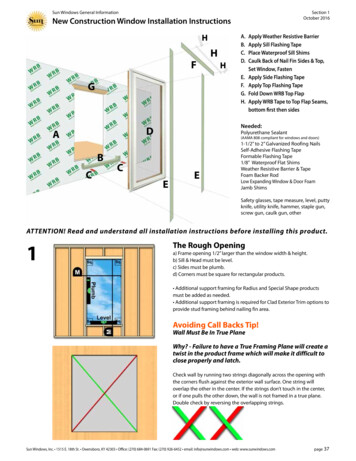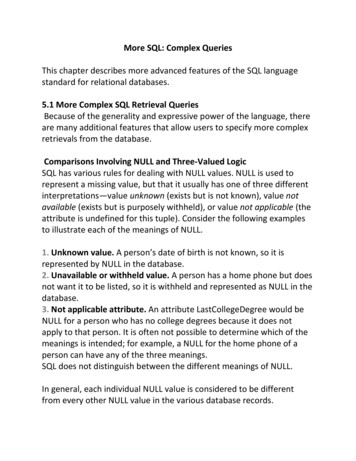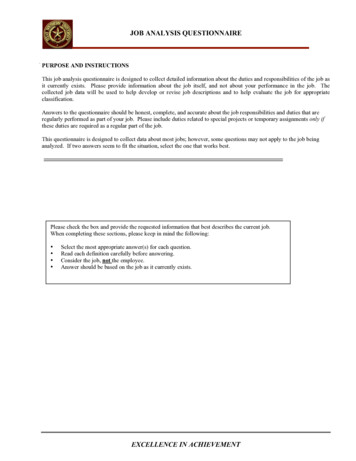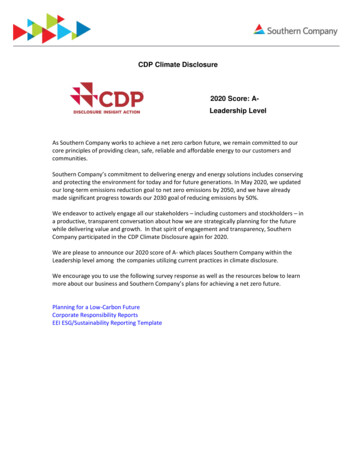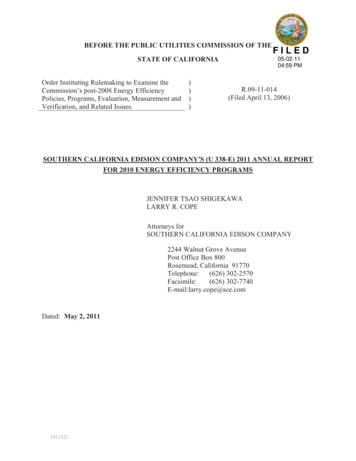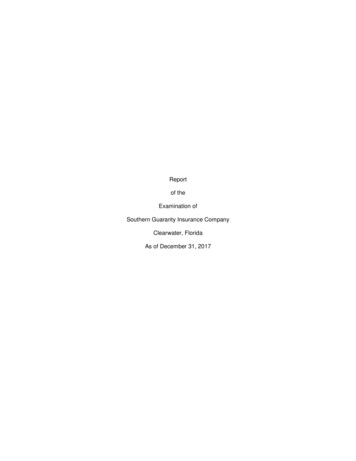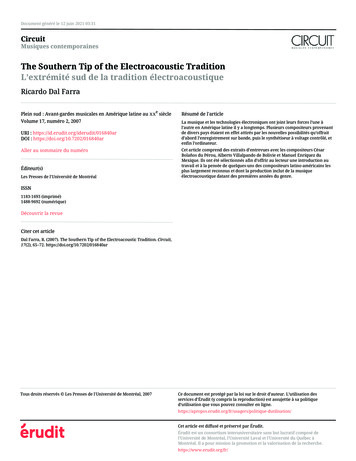
Transcription
Document généré le 12 juin 2021 03:31CircuitMusiques contemporainesThe Southern Tip of the Electroacoustic TraditionL’extrémité sud de la tradition électroacoustiqueRicardo Dal FarraPlein sud : Avant-gardes musicales en Amérique latine au xxe siècleRésumé de l'articleVolume 17, numéro 2, 2007La musique et les technologies électroniques ont joint leurs forces l’une àl’autre en Amérique latine il y a longtemps. Plusieurs compositeurs provenantde divers pays étaient en effet attirés par les nouvelles possibilités qu’offraitd’abord l’enregistrement sur bande, puis le synthétiseur à voltage contrôlé, etenfin l’ordinateur.URI : https://id.erudit.org/iderudit/016840arDOI : https://doi.org/10.7202/016840arAller au sommaire du numéroÉditeur(s)Les Presses de l'Université de MontréalCet article comprend des extraits d’entrevues avec les compositeurs CésarBolaños du Pérou, Alberto Villalpando de Bolivie et Manuel Enríquez duMexique. Ils ont été sélectionnés afin d’offrir au lecteur une introduction autravail et à la pensée de quelques-uns des compositeurs latino-américains lesplus largement reconnus et dont la production inclut de la musiqueélectroacoustique datant des premières années du genre.ISSN1183-1693 (imprimé)1488-9692 (numérique)Découvrir la revueCiter cet articleDal Farra, R. (2007). The Southern Tip of the Electroacoustic Tradition. Circuit,17(2), 65–72. https://doi.org/10.7202/016840arTous droits réservés Les Presses de l'Université de Montréal, 2007Ce document est protégé par la loi sur le droit d’auteur. L’utilisation desservices d’Érudit (y compris la reproduction) est assujettie à sa politiqued’utilisation que vous pouvez consulter en que-dutilisation/Cet article est diffusé et préservé par Érudit.Érudit est un consortium interuniversitaire sans but lucratif composé del’Université de Montréal, l’Université Laval et l’Université du Québec àMontréal. Il a pour mission la promotion et la valorisation de la recherche.https://www.erudit.org/fr/
The Southern Tipof the Electroacoustic TraditionMusic and electronic technologies have been matching forces for a long timein Latin America. Many composers from different countries in the region wereattracted by the new possibilities that tape recording at first, then voltagecontrolled synthesizer and computers, were offering.This article includes excerpts from interviews held with composers CésarBolaños from Peru, Manuel Enríquez from Mexico and Alberto Villalpandofrom Bolivia. These fragments were selected to offer the reader an approach tothe musical work and thought of some Latin American composers active inthe electroacoustic music field from the pioneering years.César Bolaños: Variation as finger workPeruvian composer César Bolaños1 (b. Lima, Peru, 1931) composed the firstelectroacoustic piece on tape at the claem (the Latin American Higher StudiesMusical Centre of the Torcuato Di Tella Institute), one of the main LatinAmerican centres for contemporary art during the 1960s2. He also createdmixed media works integrating advanced technologies at that time, includingcomputer assisted composition.The following two excerpts from an interview with César Bolaños held in hishouse in Lima, Peru, were recorded by the author in August, 2004.1. César Bolaños studied music in Limaat the National Conservatory of Music,then in New York at the ManhattanSchool of Music in 1959 and at the rca(Radio Corporation of America) between1960 and 1963. He moved to BuenosAires in 1963, having received a fellowship to study at Centro Latinoamericanode Altos Estudios Musicales or claem(Latin American Higher Studies MusicalCentre), Torcuato Di Tella Institute.Bolaños composed his first tapepiece at claem, Intensidad y Altura(1964), which was also the first electroacoustic music composition produced atthe Centre, while its lab was still in itsearliest stages of development.He also composed, among otherworks: Lutero, electroacoustic collage ontape (1965); Alfa-Omega, for two reciters,theatrical mixed choir, electric guitar,double bass, two percussionists, twodancers, magnetic tape, projections andlights (1967); I-10-AIFG/Rbt-1 for threereciters, French horn, trombone, electricguitar, two percussionists, two technicalricardo dal farraRicardo Dal Farra65
operators (lights and radios), nine synchronized slide projectors, magnetictape, amplified acoustic instrumentsand a programmed light signal system(controlled by perforated paper) actingas conductor (1968); and Canción sinpalabras (esepco II), for piano with twoperformers and tape (1970), computerassisted composition created in collaboration with Argentinian mathematicianMauricio Michberg.More information on César Bolañosis available in English at: hp?NumPage 1598 ,and in French at hp?NumPage 1598 2. Other photos of the Latin AmericanHigher Studies Musical Centre at theTorcuato DiTella Institute in BuenosAires are available through the DanielLanglois Foundation web site: p?NumPage 545 [the old laboratory] and p?NumPage 549 [the new laboratory]claem – Instituto Torcuato Di Tella, Buenos Aires, Argentine, 1966. The claem’s lab was renovated in 1966,following a project by its new technical director, Fernando von Reichenbach (Collection de musique électroacoustique latino-américaine, Fondation Daniel Langlois).***César Bolaños: I went to New York in 1958 and stayed there until 1963, immediately after that I went to Argentina.Ricardo Dal Farra: And then in Argentina, was Intensidad y Altura [1964] yourfirst piece?c. b.: Yes, Intensidad y Altura was the first work using electroacoustic media thatI produced at the Di Tella Institute.c i r c u i t v o lu m e 17 n u m é r o 2r. d. f.: And how did the lab get started? You were in charge of setting it up?66c. b.: The laboratory was very [hesitates] there was no lab, really, at the beginning. The engineer Bozarello was contracted, and we built the first lab together.The intention at that time was to put creative ideas into practice using electronics. And it was built up from whatever we had at our disposal, a home taperecorder, later an Ampex arrived, and then a Neumann microphone. That wasmore or less all, besides some modulators built by Bozarello himself. Everythingwas so simple. For speed variation, I would simply use my fingers.r. d. f.: Do you mean tape speed variations?c. b.: Exactly. Intensidad y Altura was produced that way with my finger!Many things were done by finger [laughs].
c. b.: Not much else. Some cymbals, small cans, and the voice reading thepoem. The poem was read backwards.r. d. f.: Really?c. b.: It was read backwards but then the tape was played backwards [laughs].That way, the voice sounded distressed. It was difficult to get that quality froma voice in any other way. The title of the poem, by César Vallejos, was also“Intesidad y Altura”.3. The complete recording as well as thescore of Interpolaciones are fully available online at the web site of TheDaniel Langlois Foundation for Art,Science, and Technology as part of theLatin American Electroacoustic MusicCollection created by the author. Audiorecording: p?NumObjet 15780&NumPage 556 Score: p?NumObjet 14580&NumPage 556 r. d. f.: And you were using an Ampex stereo tape recorder, a Grundig stereo,and a Philips mono?Video excerpt of Bolaños’ interview, inwhich he speaks about Interpolaciones:c. b.: That’s right. And the Neumann microphone. hp?NumObjet 36520&NumPage 547 r. d. f.: And a white noise generator.c. b.: That was also built by Bozarello; there was also a spring reverberator thathe built. He contributed a lot at the beginning.r. d. f.: And in 1966 you composed Interpolaciones,3 for electric guitar andtape.c. b.: Exactly. Let’s start with the tape. Some of its sounds come from electronic and others from concrète sources. But the original concrète sounds weretransformed in the lab in such a way that many of them seem to be generatedelectronically as well.r. d. f.: And for the guitar, there was a little device used for the spatial distribution of its sound?c. b.: It was originally a four-channel piece. The sound distribution over thosechannels could be controlled using some micro-switches the guitar performerhad close to his feet. Using those micro-switches you could make the soundjump from the front speaker to any other.r. d. f.: Julio [Viera, who premiered the piece], was playing the guitar andcontrolling the guitar sound distribution over the concert space.c. b.: Only the guitar sounds, not those from the tape.Manuel Enríquez: Electroacoustics through a crystalThe composer, conductor and performer Manuel Enríquez4 (b. Ocotlán,Mexico, 1926 - d. Mexico City, Mexico, 1994) was one of the major figures ofMexican new music in the late 20th century. In Mexico, he was the director of4. Manuel Enríquez Salazar studiedmusic with his father, later with IgnacioMacarena and Miguel Bernal Jiménezand then at The Juilliard School ofMusic in New York. In 1971 he was recipient of the Guggenheim Foundation’sfellowship and studied at the ColumbiaPrinceton Electronic Music Center.In Mexico, Enríquez was violinist atthe Guadalajara Symphonic Orchestraand the National Symphonic Orchestra,and director of the NationalConservatory of Music, the NationalMusic Research and DocumentationCentre and the National Institute ofFine Arts.He was a prolific and innovativecomposer, some of his works are:Cuarteto I for string quartet (1959);Cuatro piezas for cello and piano (1961);Sonatina for cello (1962); Cuarteto II forstring quartet; Díptico I for flute andpiano (1969); 3 x Bach for violin andtape (1970); Mixteria for actress, fourmusicians and electronic sounds (1970);Díptico II for violin and piano (1971);Viols for one string instrument (afterMóvil II, 1969) and tape (1972); Láser Ifor tape (1972); Ritual for orchestra(1973); Trauma for actress, four musicians and electronic sounds (1974);Contravox for mixed choir, percussionsand tape (1976); Del viaje inmóvil forvoices, musical instruments, electronicricardo dal farrar. d. f.: And what else did you use to produce Intensidad y Altura?67
sounds and images (1976); La casa del solfor musicians, dancers, actors and electronic sounds (1976); Conjuro for doublebass and tape (1976-77); Sonatina fororchestra (1980); Misa prehistórica forelectronic sounds (1980); Interminadosueño for actress and orchestra (1981); AJuarez, cantata for baritone, choir andorchestra (1983); Manantial de Soles forsoprano, actor and orchestra (1984);Cuarteto IV for string quartet (1984);Interecos for percussion and electronicsounds (1984); and Díptico III for percussion and string orchestra (1987). Moreinformation on Manuel Enríquez isavailable in English at http://www.fondation-langlois.org/ flash/e/ index.php?NumPage 1602 and in French .php?NumPage 16025. An audio extract from the Enríquezinterview is available online at TheDaniel Langlois Foundation web site at: p?NumObjet 36580&NumPage 1602 c i r c u i t v o lu m e 17 n u m é r o 26. The complete recording as well as thescore of Enríquez’ Viols (Móvil II) for anystring instrument and tape, are fullyavailable online at the web site of TheDaniel Langlois Foundation for Art,Science, and Technology as part of theLatin American Electroacoustic MusicCollection created by the author. Audiorecording: hp?NumObjet 15810&NumPage 556 68Score: p?NumObjet 16850&NumPage 556 Program notes in English are availableat hp?NumPage 1661 and in French at hp?NumPage 1661 7. Although an abundance of tapemusic was being produced in Mexico inthe 1960s, the first Electronic Music Labin Mexico was only established in 1970,at the National Conservatory of Music.several major music institutions and as a violinist he performed worldwide.Enríquez has an extensive catalog including orchestra, chamber, and electroacoustic compositions.The following excerpts have been taken from aninterview with Enríquez recorded in Tacuarembó, Uruguay, in April, 19925.***Manuel Enríquez: [ ] This is what I remember6 [ ] It was the foundationof the Electronic Music Lab in the Conservatory [the National Conservatoryof Music in Mexico City], as part of the Composition Workshop led by CarlosChávez.7Ricardo Dal Farra: Raúl Pavón was in charge of the lab, and HéctorQuintanar.8m. e.: Quintanar was the artistic director, but Pavón was the technical director[ ] In 1972, I was appointed director of the National Conservatory and I triedto breathe new life into the laboratory. I was also creating electronic music, butnot only there. At that lab I used to assemble and mix, but I was travelling a lotat that time. I also produced works at Columbia [the Columbia-PrincetonElectronic Music Centre in New York] [ ] After that I returned to Mexico,and composed some other works—old pieces, but I still like them [ ]. Then Imoved to Paris around 1975. I lived there for three years and had the opportunity to work for a short time at the Pantin laboratory. It was Jean-Étienne Marie’ssmall studio, in the north of Paris. Fernand Vandenbogaerde and MichelDecoust were there [ ]. I composed some pieces there; I think the main workwas the one I wrote for the double-bass player Bertram Turetzky, for doublebass and tape. Later I composed a second version for violin and tape.r. d. f.: Is that the piece Viols or Conjuro?m. e.: Conjuro. I produced Viols at Columbia, in parenthesis, on a bet fromMario Davidovsky, who used t
Only the guitar sounds, not those from the tape. Manuel Enríquez: Electroacoustics through a crystal The composer, conductor and performer Manuel Enríquez4 (b. Ocotlán, Mexico, 1926 - d. Mexico City, Mexico, 1994) was one of the major figures of Mexican new music in the late 20th century. In Mexico, he was the director of 3. The complete .
